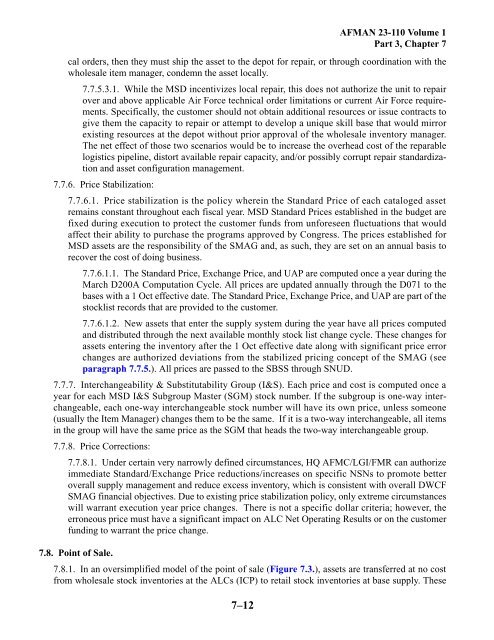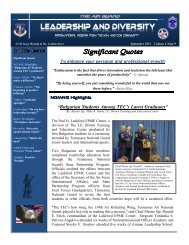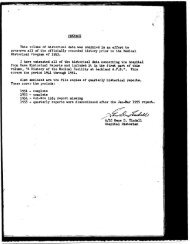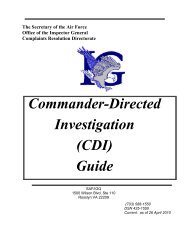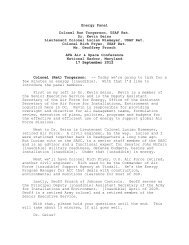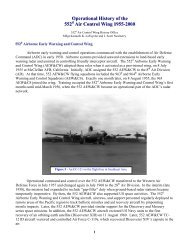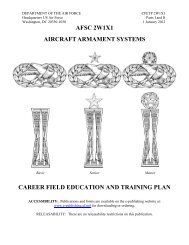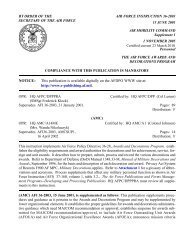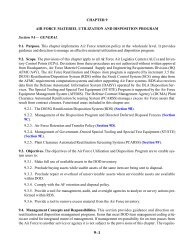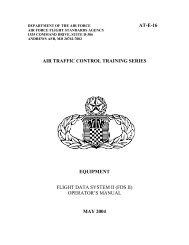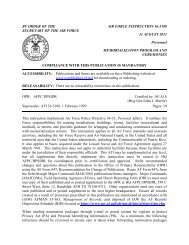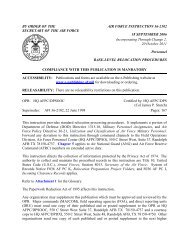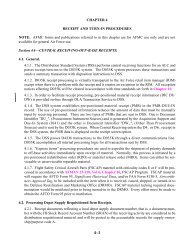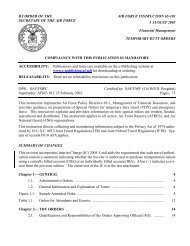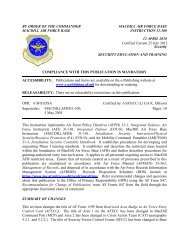Material support division, working capital fund - Air Force Link
Material support division, working capital fund - Air Force Link
Material support division, working capital fund - Air Force Link
Create successful ePaper yourself
Turn your PDF publications into a flip-book with our unique Google optimized e-Paper software.
7–12<br />
AFMAN 23-110 Volume 1<br />
Part 3, Chapter 7<br />
cal orders, then they must ship the asset to the depot for repair, or through coordination with the<br />
wholesale item manager, condemn the asset locally.<br />
7.7.5.3.1. While the MSD incentivizes local repair, this does not authorize the unit to repair<br />
over and above applicable <strong>Air</strong> <strong>Force</strong> technical order limitations or current <strong>Air</strong> <strong>Force</strong> requirements.<br />
Specifically, the customer should not obtain additional resources or issue contracts to<br />
give them the capacity to repair or attempt to develop a unique skill base that would mirror<br />
existing resources at the depot without prior approval of the wholesale inventory manager.<br />
The net effect of those two scenarios would be to increase the overhead cost of the reparable<br />
logistics pipeline, distort available repair capacity, and/or possibly corrupt repair standardization<br />
and asset configuration management.<br />
7.7.6. Price Stabilization:<br />
7.7.6.1. Price stabilization is the policy wherein the Standard Price of each cataloged asset<br />
remains constant throughout each fiscal year. MSD Standard Prices established in the budget are<br />
fixed during execution to protect the customer <strong>fund</strong>s from unforeseen fluctuations that would<br />
affect their ability to purchase the programs approved by Congress. The prices established for<br />
MSD assets are the responsibility of the SMAG and, as such, they are set on an annual basis to<br />
recover the cost of doing business.<br />
7.7.6.1.1. The Standard Price, Exchange Price, and UAP are computed once a year during the<br />
March D200A Computation Cycle. All prices are updated annually through the D071 to the<br />
bases with a 1 Oct effective date. The Standard Price, Exchange Price, and UAP are part of the<br />
stocklist records that are provided to the customer.<br />
7.7.6.1.2. New assets that enter the supply system during the year have all prices computed<br />
and distributed through the next available monthly stock list change cycle. These changes for<br />
assets entering the inventory after the 1 Oct effective date along with significant price error<br />
changes are authorized deviations from the stabilized pricing concept of the SMAG (see<br />
paragraph 7.7.5.). All prices are passed to the SBSS through SNUD.<br />
7.7.7. Interchangeability & Substitutability Group (I&S). Each price and cost is computed once a<br />
year for each MSD I&S Subgroup Master (SGM) stock number. If the subgroup is one-way interchangeable,<br />
each one-way interchangeable stock number will have its own price, unless someone<br />
(usually the Item Manager) changes them to be the same. If it is a two-way interchangeable, all items<br />
in the group will have the same price as the SGM that heads the two-way interchangeable group.<br />
7.7.8. Price Corrections:<br />
7.7.8.1. Under certain very narrowly defined circumstances, HQ AFMC/LGI/FMR can authorize<br />
immediate Standard/Exchange Price reductions/increases on specific NSNs to promote better<br />
overall supply management and reduce excess inventory, which is consistent with overall DWCF<br />
SMAG financial objectives. Due to existing price stabilization policy, only extreme circumstances<br />
will warrant execution year price changes. There is not a specific dollar criteria; however, the<br />
erroneous price must have a significant impact on ALC Net Operating Results or on the customer<br />
<strong>fund</strong>ing to warrant the price change.<br />
7.8. Point of Sale.<br />
7.8.1. In an oversimplified model of the point of sale (Figure 7.3.), assets are transferred at no cost<br />
from wholesale stock inventories at the ALCs (ICP) to retail stock inventories at base supply. These


